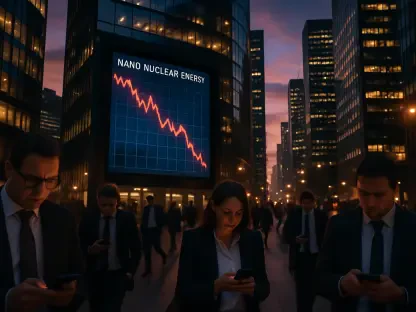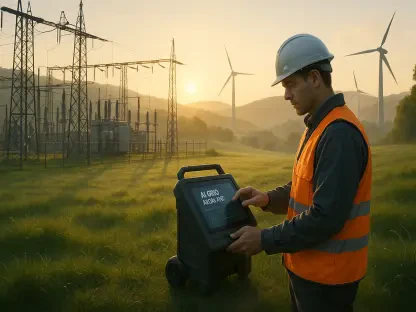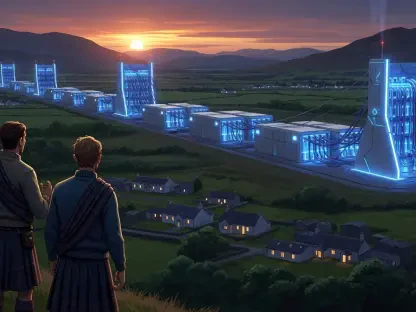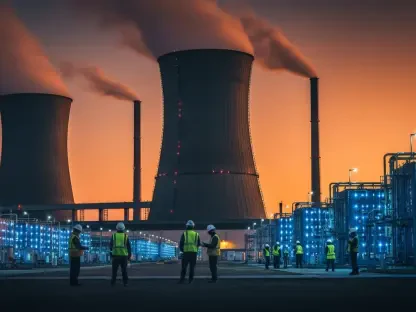The United States is facing a critical challenge as the meteoric rise of data centers, propelled by the insatiable demands of artificial intelligence (AI) and cloud computing, stretches the nation’s power infrastructure to its breaking point. These facilities, which form the backbone of the digital economy, consume energy on a scale comparable to mid-sized cities, creating a ripple effect that touches every household. As electricity demand surges, utility bills are climbing at an alarming rate, placing a heavy financial burden on consumers and raising urgent questions about sustainability and fairness in the energy landscape. This escalating crisis is not just about numbers on a bill; it’s about the tension between technological progress and the capacity of existing systems to keep pace, igniting debates over who should bear the cost of this digital revolution. The intersection of innovation and infrastructure limitations is setting the stage for a complex struggle that demands immediate attention and innovative solutions.
The Economic Toll of Data Center Growth
Rising Electricity Costs
The relentless expansion of data centers across the U.S. has unleashed a wave of unprecedented energy consumption, directly driving up electricity prices for millions of households. Hyperscale facilities, often requiring between 100 and 300 megawatts of power, match the energy needs of entire urban centers, placing immense pressure on already strained grids. In regions like the PJM Interconnection, which serves 13 states, the impact is starkly visible in capacity costs that have soared from $29 per megawatt-day to $269 in recent years. This dramatic spike translates to an 18% to 25% increase in average residential electricity bills, hitting consumers hard in their daily budgets. The financial strain is not merely a statistic but a tangible hardship for families already navigating economic uncertainties, highlighting the urgent need to address how the tech industry’s growth impacts the broader population.
Beyond the raw numbers, the economic fallout from data center energy demands reveals a deeper systemic issue within the U.S. power market. As these facilities cluster in key areas, local grids face bottlenecks, forcing utilities to procure additional capacity at inflated rates, costs that inevitably trickle down to end users. The PJM grid’s escalating prices are a warning sign of what could become a nationwide trend if demand continues to outstrip supply. Moreover, the concentration of data centers in certain regions exacerbates disparities, as communities in less affected areas may escape the worst of the price hikes while others bear an outsized burden. This uneven impact fuels frustration and underscores the challenge of balancing technological advancement with equitable economic outcomes, pushing policymakers and industry leaders to confront the hidden costs of the digital age.
Community Pushback and Economic Equity
Across the nation, the rapid proliferation of data centers is meeting fierce resistance from local communities unwilling to shoulder the consequences of this tech boom. From Virginia to Arizona, residents are voicing concerns over skyrocketing utility bills alongside environmental issues like water shortages, noise pollution, and land-use conflicts. This opposition, often termed “Not In My Backyard” (NIMBYism), has led to significant disruptions, with high-profile setbacks such as Meta’s delayed project in Mesa, Arizona, due to water resource disputes, and the cancellation of the “Digital Gateway” initiative in Prince William County, Virginia, after zoning approvals were revoked. These cases reflect a growing public sentiment that the benefits of data centers—often touted as economic drivers—do not outweigh the immediate drawbacks felt by those living nearby, creating a formidable barrier to expansion.
In response to this mounting discontent, a shift in policy is underway to address the inequities tied to data center energy consumption. At least 12 states are actively drafting or considering regulations to ensure that these facilities internalize the costs of their massive power needs rather than passing them on to ordinary consumers. This marks a pivotal change in approach, as legislators grapple with protecting constituents from financial strain while still fostering tech-driven growth. The emerging frameworks aim to create special rate structures or direct infrastructure investment from data center operators, signaling a broader push for accountability. However, the challenge lies in striking a balance that satisfies public demands without stifling innovation, as state-level debates become battlegrounds for defining the future relationship between technology and community welfare.
Energy Solutions and Infrastructure Challenges
Short-Term Fixes: Renewables and Storage
As the energy demands of data centers continue to surge, immediate solutions are critical to prevent grid failures and curb escalating costs for consumers. Solar power and energy storage have emerged as frontline tools, accounting for roughly 80% of new power generation capacity added to the U.S. grid in recent times, with significant contributions in utility-scale solar and battery systems. These renewable options offer a rapid response to rising demand, aligning with sustainability goals and reducing reliance on fossil fuels in the near term. Major tech companies are increasingly investing in these technologies to power their facilities, driven by both environmental commitments and the need for scalable energy sources. Yet, while solar and storage provide a promising start, their deployment must accelerate to keep pace with the exponential growth of digital infrastructure needs across the country.
Despite their potential, renewables like solar power face inherent limitations that prevent them from fully resolving the energy crisis tied to data centers. The intermittent nature of solar—dependent on weather and daylight—means it cannot deliver the consistent, 24/7 baseload power required by always-on facilities. Energy storage helps bridge this gap, but current battery capacities are often insufficient for prolonged outages or peak demand periods. As a result, dispatchable sources like natural gas remain indispensable in the short term, providing reliability when renewables falter. This reliance on gas as a backup highlights the complexity of transitioning to a cleaner grid while meeting immediate needs, underscoring that a single solution cannot address the multifaceted challenges posed by data center expansion. A balanced mix of technologies is essential to ensure stability during this critical period of adjustment.
Long-Term Vision: Nuclear and Beyond
Looking toward the future, the energy sector is pivoting to more sustainable and robust solutions to support the unrelenting power needs of data centers while addressing grid constraints. Nuclear power, particularly through the development of small modular reactors (SMRs), is increasingly viewed as a cornerstone for providing reliable baseload energy beyond the 2030s. Unlike renewables, nuclear offers consistent output unaffected by weather or time of day, making it an ideal match for the constant demands of hyperscale facilities. Tech giants such as Microsoft, Amazon, and Google are already forging agreements with nuclear energy providers, signaling a strategic shift toward long-term sustainability. This growing interest reflects a broader recognition that while short-term fixes are vital, only transformative technologies can ensure the scalability required for the next era of digital growth.
However, the path to a nuclear-powered future is not without hurdles, and it must be complemented by a diversified energy strategy to address both technical and societal tensions. The timeline for widespread adoption of SMRs remains distant due to regulatory, safety, and cost considerations, necessitating continued reliance on natural gas as a transitional fuel to maintain grid stability. Analysts advocate for an “all of the above” approach, integrating renewables, storage, gas, and nuclear to create a resilient energy ecosystem capable of supporting AI-driven workloads. Beyond technology, this vision requires navigating public concerns and policy challenges to ensure equitable cost distribution and minimal environmental impact. The clash between data center growth and infrastructure limits has exposed systemic vulnerabilities, but it also presents an opportunity to redefine how energy and innovation coexist for a balanced and sustainable future.
Navigating Systemic Shifts
Reflecting on the unfolding energy crisis, it’s evident that the collision between data center expansion and U.S. power infrastructure has tested the limits of existing systems in profound ways. The dramatic rise in electricity costs, epitomized by the PJM grid’s capacity price surges, has burdened households with unexpected financial strain, while community opposition in states like Arizona and Virginia has halted critical projects over diverse concerns. State policies have adapted by introducing measures to hold data centers accountable for their energy footprints, marking a historic shift toward fairness. On the energy front, solar and storage have provided crucial relief, though natural gas has played a necessary supporting role, with nuclear energy emerging as a distant but promising goal. Moving forward, the focus must shift to accelerating renewable deployment, refining cost-allocation frameworks, and fostering dialogue between tech industries and communities to build a grid that supports innovation without sacrificing equity or stability.









